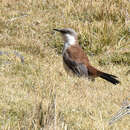en
names in breadcrumbs


The white-bellied cinclodes (Cinclodes palliatus) is a species of bird in the ovenbird family, Furnariidae. It is endemic to Peru where it inhabits high level, marshy grassland in the Junín Region and possibly also in the Huancavelica Region. This is a very large furnariid with dark upper parts and gleaming white underparts. It is a rare bird with very specific habitat requirements and is threatened by habitat destruction. The International Union for Conservation of Nature has assessed it as being "critically endangered".
The white-bellied cinclodes is larger and has a longer tail than other members of its genus and more resembles a mockingbird than a typical Cinclodes. It grows to a length of about 24 cm (9 in). The crown is brownish-grey, the upper parts and wings rufous-brown with a broad white wing bar, and the underparts pure white. This bird's song is a rapid chattering "pipipipipi pi pi" that sometimes speeds up into a piping, higher-pitched "wee wee wee wee wee".[2][3]
This species is known only from a high altitude strip of land in Junín Region in Peru. It has previously also been recorded in the Huancavelica Region but recent surveys of that area have failed to find it. It has very specific habitat requirements; it needs mineral-rich, boggy terrain where such cushion plants as Distichia grow, with crags and rocky slopes nearby. Its altitudinal range is about 4,430 m (14,530 ft) to the snowline at around 5,000 m (16,400 ft). This habitat is often found near the foot of glaciers, but there is much apparently suitable habitat where the birds are not present.[1]
The white-bellied cinclodes forages in pairs or small groups, pushing its beak into the wet ground to find worms and other invertebrates. Its breeding habits are not well known, but the nest is usually hidden in a rock crevice.[1]
As a result of a survey in 2003, the number of birds was estimated to be in the range 200–1000. No previously unknown locations were found. Between 2008 and 2011, further survey work was undertaken; 104 bogs were visited and 113 birds were recorded inhabiting 18 of them, giving an estimated total population of birds of under 300. Their habitat is being disturbed by mining activities and the dumping of spoil from mines, the extraction of peat, and overgrazing by alpacas, llamas and sheep. If these activities continue there is a poor outlook for the birds, and as a result the International Union for Conservation of Nature have assessed them as being "critically endangered".[1]
The white-bellied cinclodes (Cinclodes palliatus) is a species of bird in the ovenbird family, Furnariidae. It is endemic to Peru where it inhabits high level, marshy grassland in the Junín Region and possibly also in the Huancavelica Region. This is a very large furnariid with dark upper parts and gleaming white underparts. It is a rare bird with very specific habitat requirements and is threatened by habitat destruction. The International Union for Conservation of Nature has assessed it as being "critically endangered".